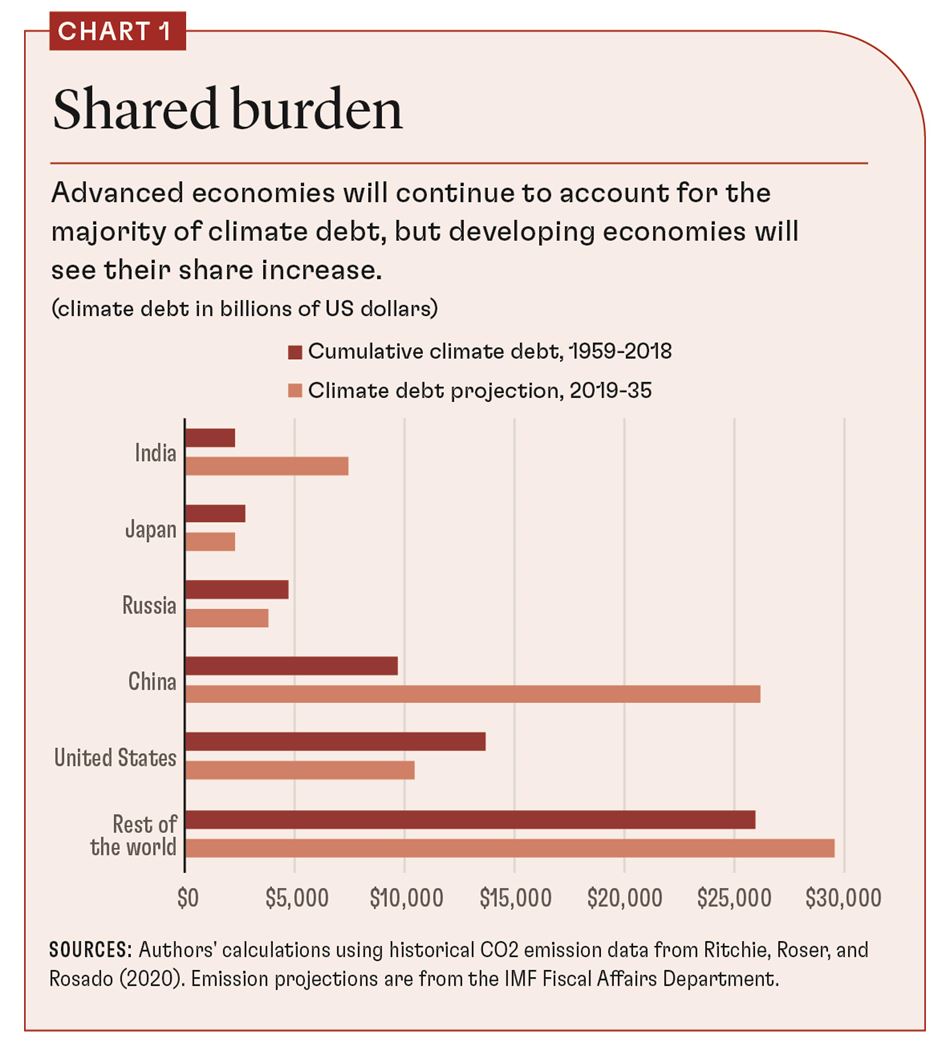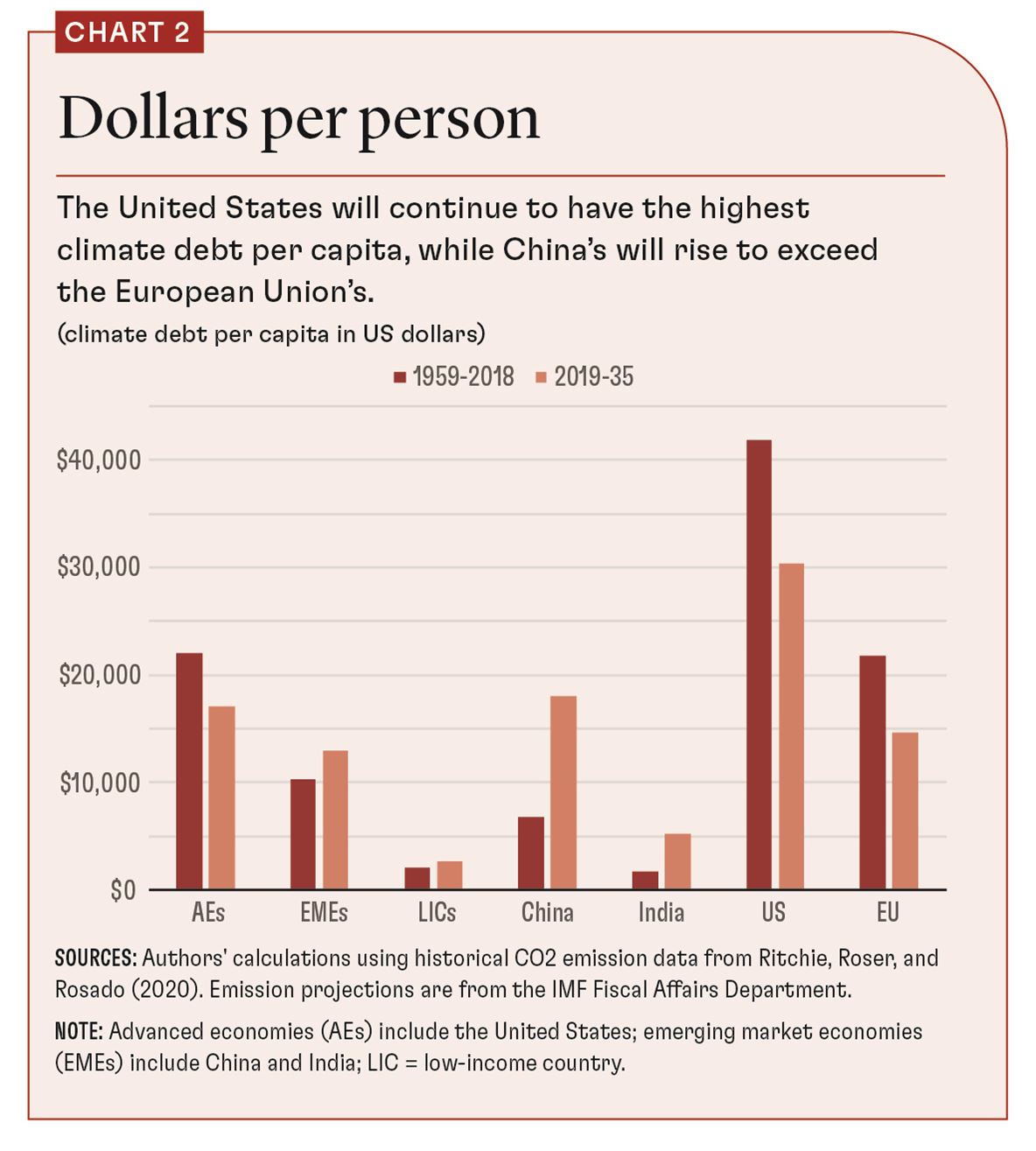Putting a dollar figure on emission damages helps assess each country’s fair share of the climate burden
More than 190 countries have pledged under the 2015 Paris Agreement to reduce carbon emissions, including from fossil fuel consumption, by 2030 to avoid the negative effects of rising global temperatures. However, there is a large gap between what countries have committed to do and what needs to be done. That said, countries could further reduce emissions beyond 2030.
Countries, including most Group of Twenty (G20) members, have already voluntarily pledged what they believe they can or should contribute to reducing emissions. But it may be more practical to call on the richest nations to compensate developing economies for the damage inflicted on them by climate change.
Here, the concept of “climate debt” may be useful. Climate debt represents the sum of emission damages—that is, the cumulative negative effects of carbon dioxide emissions, whose costs are imposed on the globe without compensation. We estimate climate debt for 131 countries based on both historical and projected carbon emissions (Clements, Gupta, and Liu 2023). Such estimates are relevant for determining each country’s fair contribution toward slowing emissions and for discussion of the appropriate compensation for developing economies. Countries with large climate debt could be asked to share a proportionally higher burden, but this may be challenging for countries with high public debt and limited fiscal space. One consideration when it comes to who should pay climate debt is the ability to pay; from this perspective, less would be expected from developing economies.
Calculating climate debt
Climate debt can be estimated based on actual and projected emissions and the social cost of carbon, which measures the economic damage per ton of CO2 emissions. We find climate debt to be extremely large—some $59 trillion over 1959–2018 (Chart 1)—and projected to increase by another $80 trillion during 2019–35. The size of each country’s climate debt reflects both the size of its economy (which is positively correlated with emissions) and how intensively it uses fossil fuels (thus generating emissions) for every dollar of economic output. The composition of energy use (for example, heavy use of coal) has an impact as well. As of 2018, the largest contributors were the United States ($14 trillion), China ($10 trillion), and Russia ($5 trillion). Beginning in 2018, developing economies will account for a larger share of climate debt, given their relatively higher economic growth.
It can be argued that each global citizen has an equal right to an environment unaffected by climate change. This implies that countries with high climate debt because of their high emissions should compensate countries that have caused less damage to the environment.
Our data show large differences across countries in per capita climate debt (Chart 2). Climate debt per capita is highest in the United States—some 6 times higher than in China for the 1959–2018 period and 25 times as high as in India. For 2019–35, climate debt per capita will remain highest in the United States and will rise in China, exceeding the expected level in the European Union.
Climate debt is substantial relative to government debt; in G20 countries, it is about 81 percent of GDP, compared with average general government debt of 88 percent of GDP in 2020. It is large relative to the fiscal burden expected from increases in public spending on health and pensions; in net present value terms, these outlays are projected to average 25 percent of GDP in G20 countries during 2020–35.
To assess plans to curb emissions and their likely impact on climate debt, we consider two scenarios. The 2015 Paris Agreement established a framework to limit global warming to well below 2°C and to pursue efforts to limit it to 1.5°C above the preindustrial average. The Paris Agreement works on a five-year cycle of climate action by countries. Every five years, countries submit nonbinding actions planned to reduce their greenhouse gas emissions to reach the Paris Agreement goals. These are known as Nationally Determined Contributions, or NDCs.
Debt keeps accumulating
In our first scenario, we assess the impact of full implementation of countries’ NDCs on climate debt, assuming a gradual reduction in emissions for each country each year to meet the target in 2030. The net result of country NDCs is a reduction in the accumulation of climate debt by $9.6 trillion (24 percent). While sizable, this reduction pales in comparison with our projected 2019–35 accumulation. Furthermore, countries whose emissions decline significantly (China, United States) would still contribute the most to the accumulation of climate debt ($12.9 billion and $5.4 billion, respectively). This suggests that NDC implementation alone is not enough for fair burden sharing across countries in reducing climate debt.
In our second scenario, we evaluate how much emissions and climate debt would need to fall, beyond what is promised in countries’ NDCs, to achieve the 1.5°C goal under the Paris Agreement. Under this setup, it would seem logical to ask countries with large climate debt to make the greatest contributions to help close this gap. Many advanced economies with significant climate debt, such as the United States, Japan, and Germany, however, have already pledged in their NDCs to reduce emissions sharply by 2030. Thus, a more feasible approach might be to ask countries for additional reductions on the basis of their share of total emissions for that year. If this additional reduction were undertaken by each G20 country beyond its NDC, for example, projected climate debt would fall by an additional $6.4 trillion. These emission reductions would still strike many as unfair, however, because climate debt per capita in the United States and other advanced economies would still far surpass that of G20 developing economies.
This exercise demonstrates that it may not be feasible, between now and 2030, to reduce emissions in a manner that is perceived as fair, given the shrinking share of advanced economies in global emissions. Instead, advanced economies may need to focus on reducing emissions over a longer time period or aggressively compensating developing economies for the damage caused by climate change, including through more generous climate financing.
The role of fiscal policy
Government taxation and spending policies are potent tools for taming the growth of climate debt. At the same time, countries face constraints in pursuing climate action because of the impact of the pandemic on their economies and the associated steep increases in public debt. The US and Europe have embraced large-scale policies to subsidize clean energy to reduce climate debt, but this option is not open to developing economies given their lack of fiscal space. That said, both country groups should pay attention to the revenue side, in particular higher taxation of energy, with carbon taxes to reduce climate debt. This would reduce emissions while helping countries fund additional spending. Carbon taxation must be accompanied by complementary fiscal policies to offset the tax’s short-term adverse effects on low-income households.
There are important ethical considerations countries must address as they seek to implement tax and spending policies to reduce emissions. Which generation should bear the burden of adjusting to a lower-emissions economy? Given that the damage from emissions is rising over time, countries are better off acting as soon as possible. The current generation has already consumed large amounts of energy at prices that did not fully reflect its true social cost, including its damage to the environment. For developing economies, however, the adjustment could be phased in gradually, given these countries’ greater ability to shoulder the burden as their per capita incomes rise over time.
A pragmatic approach
Climate debt from CO2 emissions is large and unevenly spread across the world’s economies. The size of the debt—and its disparity among countries—portends contentious discussions on countries’ fair burden in slowing climate change and the level of assistance to developing economies to compensate for these differences.
Climate debt per capita is projected to be much higher in advanced than in developing economies, even under full implementation of NDCs by G20 countries. This implies that advanced economies may need to make additional efforts to achieve fair burden sharing in the fight against climate change. Implementing the required reductions in emissions to meet the Paris targets is problematic, given that advanced economies—which have accumulated a large share of the stock of climate debt—are already reducing their emissions sharply under their NDCs. Thus, a more pragmatic approach to fair distribution of the burden is for advanced economies to ramp up their assistance to developing economies. This means climate finance to pay for mitigation and adaptation to the impacts of climate change, through grants and concessional loans. The IMF’s new Resilience and Sustainability Facility is extending concessional financing for climate transition and pandemic preparedness to developing economies. However, current climate finance has not yet reached the goal of $100 billion a year and is clearly inadequate in light of the huge climate debt of advanced economies.
Opinions expressed in articles and other materials are those of the authors; they do not necessarily reflect IMF policy.
References:
Clements, Benedict, Sanjeev Gupta, and Jianhong Liu. 2023. “Who’s Responsible for Climate Change? New Evidence Based on Country-level Estimates of Climate Debt.” Economics of Energy and the Environment 12 (1). https://0-doi-org.library.svsu.edu/10.5547/2160-5890.12.1.bcle.
International Monetary Fund (IMF). 2019. Fiscal Monitor: How to Mitigate Climate Change. Washington, DC, September. https://0-www-imf-org.library.svsu.edu/en/Publications/FM/Issues/2019/09/12/fiscal-monitor-october-2019.
Ritchie, Hannah, Max Roser, and Pablo Rosado. 2020. “CO2 and Greenhouse Gas Emissions.” Published online at OurWorldInData.org.
https://ourworldindata.org/co2-and-other-greenhouse-gas-emissions.













